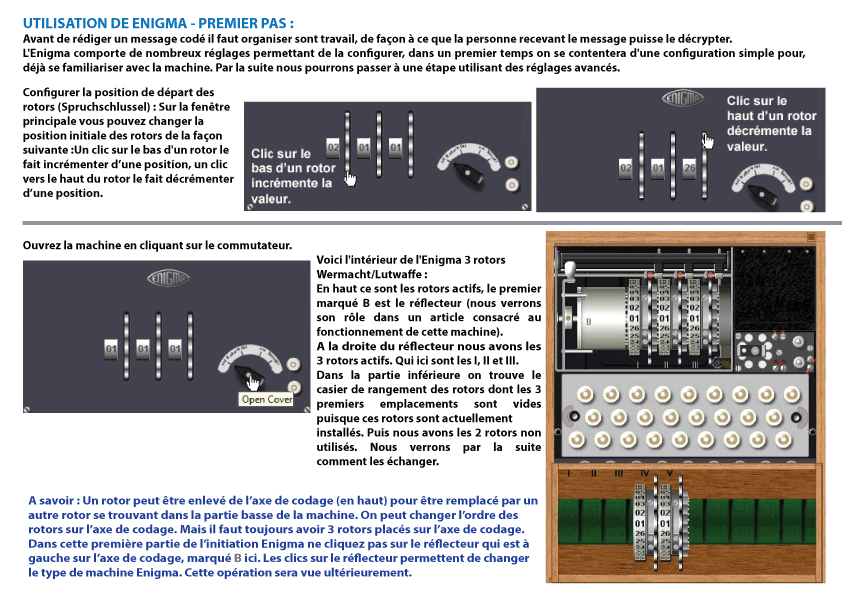

V connects to S to W to X on the reflector, then out from Z to C to B to E for the return path. Shift the third rotor once then trace the final letter, V, through the path. The next encrypted letter is B which follows the path D to F to B on the reflector, then out from D to G to E to C for the return path. Remember to shift the third rotor one step after each output letter. On the Reflector, L reflects back to G, then to D on Rotor 3, then to C on Rotor 2, and finally to A on Rotor 1 which is aligned with A on our Input rotor. Trace the path from the Input rotor from L across Rotor 1 to M on Rotor 2, then to K on Rotor 3, and through L on the Reflector. The first letter of the encrypted word is L. The word ACE when encrypted through this setup of the Enigma is LBV.īecause the message was encrypted with rotors in position A-A-A-A-A, it is important that the Enigma starts with that position. Encode the letter E by finding it and tracing the path to and from the Reflector. Shift Rotor 3 “up” one time (because we got our output letter from before). Trace it across rotors 1, 2, and 3, through the reflector and back through 3, 2, and 1. To encode our next letter, locate the letter C on the Input rotor. This means that L is the encrypted letter A.Īfter you get an output letter, rotate Rotor 3 on letter “up”. When you get to Rotor 1, the output letter should be L. Follow the paths back through each of the rotors.

Follow the path from G on the Reflector to the output letter of the Reflector. The path leads to the letter G on the Reflector. Now follow the path from D on Rotor 3 to the Reflector. The path leads to the letter D on Rotor 3. Now follow the path from C on Rotor 2 to Rotor 3. The path leads to the letter C on Rotor 2.

Follow the path from A on Rotor 1 to Rotor 2. Follow the path from A on the input rotor to the letter A on Rotor 1. Starting from the left, locate the letter A on the input rotor. Later, the start positions of each rotor will change, but for now leave them all aligned with A. Aligning the Input Rotors 1, 2, 3 and the Reflector at Input position A is said to be set to A-A-A-A-A. Align the rotors so all the A letters line up. There are many start positions each rotor and the reflector can be set for. What follows will guide you through the creation of your very own Enigma machine. There are countless stories of other encryption techniques, but none has intrigue and impact that the German Enigma had during World War 2. The Enigma remains perhaps the most popular encryption device in history. However, because Colossus was classified, the University of Pennsylvania’s ENIAC was publicly given the crown of “first computer.”
#Enigma simulator c crack#
Colossus was used to crack the Lorenz cipher which was an even more complex than Enigma. The Bombe was an incredible feat of engineering and the predecessor of the first true electronic computer named Colossus. This gave the Allies the ability to quickly read German encrypted messages and help win the war. Thanks to the work of British mathematician Alan Turing, the Allies developed The Bombe, a top-secret electronic machine used to quickly try every possible combination of letters in order to crack the Enigma code. Each key press on the keyboard would turn a rotor one step and provide a new, different path for the electricity to flow inside the machine. The Enigma operator would then key in each “random” letter and write down the resulting letter that was lit up on the machine.
#Enigma simulator c code#
They would copy seemingly random letters via Morse Code from the radio. Soldiers in the field and sailors at sea would set their Enigma machines’ rotors to the same as the person sending a message. For example, a T might be pressed but the letter G would light up. The operator would press a key on the keyboard which would activate an electric circuit and light up a different letter. The most simple models had three wheels on top of the case that allowed the operator to set internal rotors into a certain position. The Enigma was an electro-mechanical machine similar to a typewriter.


 0 kommentar(er)
0 kommentar(er)
